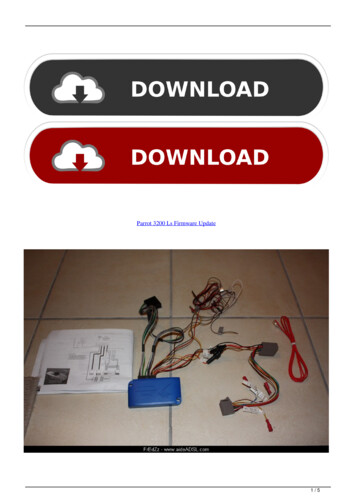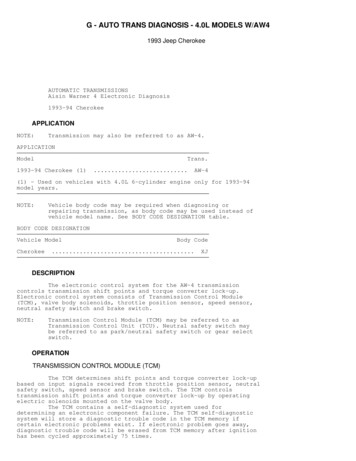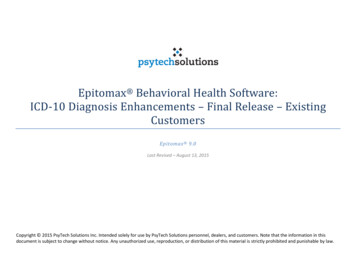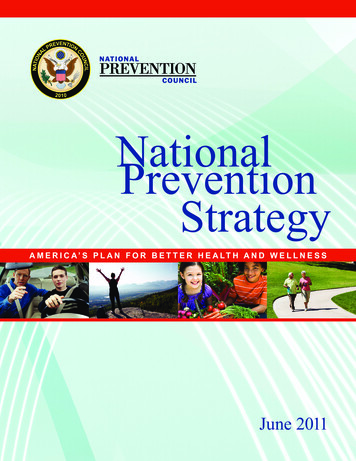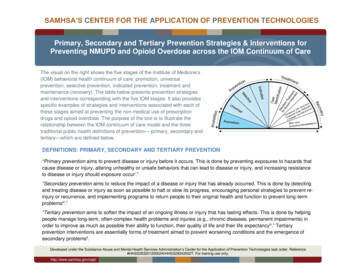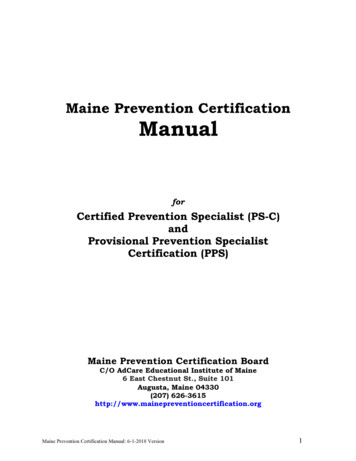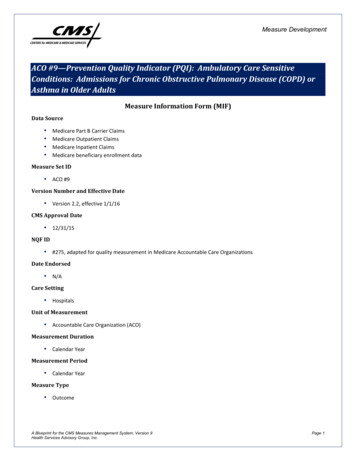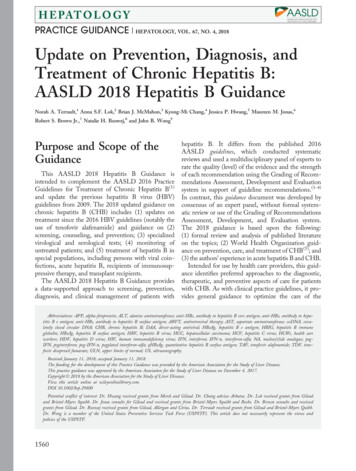
Transcription
A MERICAN A SSOCIATION FORT HE STUDY OF LIVER D I S E ASESPRACTICE GUIDANCE HEPATOLOGY, VOL. 67, NO. 4, 2018Update on Prevention, Diagnosis, andTreatment of Chronic Hepatitis B:AASLD 2018 Hepatitis B GuidanceNorah A. Terrault,1 Anna S.F. Lok,2 Brian J. McMahon,3 Kyong-Mi Chang,4 Jessica P. Hwang,5 Maureen M. Jonas,6Robert S. Brown Jr.,7 Natalie H. Bzowej,8 and John B. Wong9Purpose and Scope of theGuidanceThis AASLD 2018 Hepatitis B Guidance isintended to complement the AASLD 2016 PracticeGuidelines for Treatment of Chronic Hepatitis B(1)and update the previous hepatitis B virus (HBV)guidelines from 2009. The 2018 updated guidance onchronic hepatitis B (CHB) includes (1) updates ontreatment since the 2016 HBV guidelines (notably theuse of tenofovir alafenamide) and guidance on (2)screening, counseling, and prevention; (3) specializedvirological and serological tests; (4) monitoring ofuntreated patients; and (5) treatment of hepatitis B inspecial populations, including persons with viral coinfections, acute hepatitis B, recipients of immunosuppressive therapy, and transplant recipients.The AASLD 2018 Hepatitis B Guidance providesa data-supported approach to screening, prevention,diagnosis, and clinical management of patients withhepatitis B. It differs from the published 2016AASLD guidelines, which conducted systematicreviews and used a multidisciplinary panel of experts torate the quality (level) of the evidence and the strengthof each recommendation using the Grading of Recommendations Assessment, Development and Evaluationsystem in support of guideline recommendations.(1-4)In contrast, this guidance document was developed byconsensus of an expert panel, without formal systematic review or use of the Grading of RecommendationsAssessment, Development, and Evaluation system.The 2018 guidance is based upon the following:(1) formal review and analysis of published literatureon the topics; (2) World Health Organization guidance on prevention, care, and treatment of CHB(5); and(3) the authors’ experience in acute hepatitis B and CHB.Intended for use by health care providers, this guidance identifies preferred approaches to the diagnostic,therapeutic, and preventive aspects of care for patientswith CHB. As with clinical practice guidelines, it provides general guidance to optimize the care of theAbbreviations: AFP, alpha-fetoprotein; ALT, alanine aminotransferase; anti-HBc, antibody to hepatitis B core antigen; anti-HBe, antibody to hepatitis B e antigen; anti-HBs, antibody to hepatitis B surface antigen; ARVT, antiretroviral therapy; AST, aspartate aminotransferase; cccDNA, covalently closed circular DNA; CHB, chronic hepatitis B; DAA, direct-acting antiviral; HBeAg, hepatitis B e antigen; HBIG, hepatitis B immuneglobulin; HBsAg, hepatitis B surface antigen; HBV, hepatitis B virus; HCC, hepatocellular carcinoma; HCV, hepatitis C virus; HCWs, health careworkers; HDV, hepatitis D virus; HIV, human immunodeficiency virus; IFN, interferon; IFN-a, interferon-alfa; NA, nucleos(t)ide analogue; pegIFN, peginterferon; peg-IFN-a, pegylated interferon-alfa; qHBsAg, quantitative hepatitis B surface antigen; TAF, tenofovir alafenamide; TDF, tenofovir disoproxil fumarate; ULN, upper limits of normal; US, ultrasonography.Received January 11, 2018; accepted January 11, 2018.The funding for the development of this Practice Guidance was provided by the American Association for the Study of Liver Diseases.This practice guidance was approved by the American Association for the Study of Liver Diseases on December 4, 2017.C 2018 by the American Association for the Study of Liver Diseases.Copyright VView this article online at wileyonlinelibrary.com.DOI 10.1002/hep.29800Potential conflict of interest: Dr. Hwang received grants from Merck and Gilead. Dr. Chang advises Arbutus. Dr. Lok received grants from Gileadand Bristol-Myers Squibb. Dr. Jonas consults for Gilead and received grants from Bristol-Myers Squibb and Roche. Dr. Brown consults and receivedgrants from Gilead. Dr. Bzowej received grants from Gilead, Allergan and Cirius. Dr. Terrault received grants from Gilead and Bristol-Myers Quibb.Dr. Wong is a member of the United States Preventive Services Task Force (USPSTF). This article does not necessarily represent the views andpolicies of the USPSTF.1560
HEPATOLOGY, Vol. 67, No. 4, 2018majority of patients and should not replace clinicaljudgement for a unique patient. This guidance doesnot seek to dictate a “one size fits all” approach for themanagement of CHB. Clinical considerations may justify a course of action that differs from this guidance.Interim Data Relevant tothe AASLD 2018 HepatitisB GuidanceSince the publication of the 2016 AASLD HepatitisB Guidelines, tenofovir alafenamide (TAF) has beenapproved for treatment of CHB in adults. TAF joinsthe list of preferred HBV therapies, along with entecavir, tenofovir disoproxil fumarate (TDF), and peginterferon (peg-IFN; Tables 1 and 2)(6-16) (section: UpdatedRecommendations on the Treatment of PatientsWith Chronic Hepatitis B). Additionally, studies onthe use of TDF for prevention of mother-to-child transmission led to TDF being elevated to the level of preferred therapy in this setting (section 1C of Screening,Counseling, and Prevention of Hepatitis B).TAF, like TDF, is a nucleotide analogue that inhibits reverse transcription of pregenomic RNA to HBVDNA. TAF is more stable than TDF in plasma anddelivers the active metabolite to hepatocytes more efficiently, allowing a lower dose to be used with similarantiviral activity, less systemic exposure, and thusdecreased renal and bone toxicity.A phase 3 trial of 873 hepatitis B e antigen(HBeAg)-positive patients (26% with past nucleos(t)ide analogue [NA] therapy) randomized to TAF25 mg daily or TDF 300 mg daily in a 2:1 ratio foundTERRAULT ET AL.similar 48-week responses, with serum HBV DNA 29 IU/mL in 64% versus 67%, alanine aminotransferase (ALT) normalization in 72% versus 67%,HBeAg loss in 14% versus 12%, and hepatitis B surface antigen (HBsAg) loss in 1% versus 0.3% in theTAF and TDF groups, respectively.(17) Week 96follow-up results likewise showed that 73% and 75%had serum HBV DNA 29 IU/mL, 22% and 18%lost HBeAg, and 1% and 1% lost HBsAg in TAF andTDF patients, respectively.(6)Analogously, a phase 3 trial of 426 HBeAg-negativepatients (21% with past NA therapy) randomized toTAF 25 mg daily or TDF 300 mg daily in a 2:1 ratiofound comparable 48-week normalization in 83% versus 75% in the TAF and TDF groups, respectively.However, no patient in either group lost HBsAg.(18)Week 96 follow-up results also showed serum HBVDNA 29 IU/mL in 90% of TAF patients and 91%of TDF patients, with 1 TAF-treated patient losingHBsAg.(7) The approved dose of TAF is 25 mg orallyonce-daily, with no dose adjustment needed unless creatinine clearance is 15 mL/min.In these phase 3 studies, TAF had significantly lessdecline than TDF in bone density and renal functionat 48 weeks of treatment. In HBeAg-positive patients,the mean decline in the estimated glomerular filtrationrate was 20.6 mL/min for TAF patients, whereas thedecline was 25.4 mL/min in TDF patients(P .0001). In HBeAg-negative patients, the meandecline in the estimated glomerular filtration rate was21.8 mL/min in TAF patients, whereas the declinefor TDF patients was 24.8 mL/min (P 5 .004).(17,18)In hip and spine bone mineral density measurements,the adjusted percentage difference in spine bone mineral density for TAF versus TDF was 1.88% (95%ARTICLE INFORMATION:From the 1Division of Gastroenterology/Hepatology, University of California San Francisco, San Francisco, CA; 2Division of Gastroenterology and Hepatology, University of Michigan, Ann Arbor, MI; 3Liver Diseases and Hepatitis Program, Alaska NativeTribal Health Consortium, Anchorage, AK; 4Division of Gastroenterology, Corporal Michael J. Crescenz VA Medical Center & University of PennsylvaniaPerelman School of Medicine, Philadelphia, PA; 5Department of General Internal Medicine, The University of Texas MD Anderson Cancer Center, Houston, TX; 6Division of Gastroenterology, Hepatology and Nutrition, Boston Children’s Hospital, Boston, MA; 7Divisionof Gastroenterology and Hepatology, Weill Cornell Medical College, New York, NY; 8Ochsner Medical Center, New Orleans, LA; and9Division of Clinical Decision Making, Tufts Medical Center, Tufts University School of Medicine, Boston, MA.ADDRESS CORRESPONDENCE AND REPRINT REQUESTS TO:Norah Terrault, M.D., M.P.H.Division of Gastroenterology/Hepatology,University of California San Francisco513 Parnassus AvenueRoom S-357San Francisco, CA 94143-0358E-mail: norah.terrault@ucsf.eduTel: 11-415-476-22271561
TERRAULT ET AL.HEPATOLOGY, April 2018TABLE 1. Approved Antiviral Therapies in Adults and ChildrenPotentialSide Effects†Dose inAdults*Use IFN-a-2b(children)180 mcgweekly 1 year dose:6 million IU/m2three timesweekly§CEntecavir0.5 mgdailykCTenofovirdipovoxilfumarate300 mgdaily 2 years dose:weight-basedto 10-30 kg;above 30 kg:0.5 mg dailyk 12 yearsTenofoviralafenamide25 mgdaily—There are insufficienthuman data onuse duringpregnancy toinform adrug-associatedrisk of birth defectsand miscarriage.Lactic acidosisLamivudine100 mgdailyCPancreatitisLactic acidosisAdefovir10 mgdaily 2 yearsdose: 3 mg/kgdaily to max100 mg 12 yearsCAcute renal failureFanconi syndromeLactic acidosisTelbivudine600 mgdaily—BCreatine kinase elevationand myopathyPeripheral neuropathyLactic acidosisDrugMonitoring on Treatment‡PreferredBFlu-like symptoms, fatigue,mood disturbances,cytopenia, autoimmunedisorders in adults,anorexia and weightloss in childrenLactic acidosis(decompensatedcirrhosis only)Complete blood count (monthly to every3 months)TSH (every 3 months)Clinical monitoring for autoimmune,ischemic, neuropsychiatric, andinfectious complicationsLactic acid levels if there is clinicalconcernTest for HIV before treatment initiationNephropathy, Fanconisyndrome, osteomalacia,lactic acidosisCreatinine clearance at baselineIf at risk for renal impairment, creatinineclearance, serum phosphate, urineglucose, and protein at least annuallyConsider bone density study at baselineand during treatment in patients withhistory of fracture or risks forosteopeniaLactic acid levels if there is clinicalconcernTest for HIV before treatment initiationLactic acid levels if clinical concernAssess serum creatinine, serumphosphorus, creatinine clearance,urine glucose, and urine protein beforeinitiating and during therapy in allpatients as clinically appropriateTest for HIV before treatment initiationNonpreferredAmylase if symptoms are presentLactic acid levels if there is clinicalconcernTest for HIV before treatment initiationCreatinine clearance at baselineIf at risk for renal impairment, creatinineclearance, serum phosphate, urineglucose, and urine protein at leastannuallyConsider bone density study at baselineand during treatment in patients withhistory of fracture or risks forosteopeniaLactic acid levels if clinical concernCreatine kinase if symptoms are presentClinical evaluation if symptoms arepresentLactic acid levels if there is clinicalconcern*Dose adjustments are needed in patients with renal dysfunction.†In 2015, the U.S. Food and Drug Administration replaced the pregnancy risk designation by letters A, B, C, D, and X with morespecific language on pregnancy and lactation. This new labeling is being phased in gradually, and to date only TAF includes theseadditional data.‡Per package insert.§Peg-IFN-a-2a is not approved for children with chronic hepatitis B, but is approved for treatment of chronic hepatitis C. Providersmay consider using this drug for children with chronic HBV. The duration of treatment indicated in adults is 48 weeks.kEntecavir dose is 1 mg daily if the patient is lamivudine experienced or if they have decompensated cirrhosis.Abbreviation: TSH, thyroid stimulating hormone.1562
HEPATOLOGY, Vol. 67, No. 4, 2018TERRAULT ET AL.TABLE 2. Efficacy of Approved First-Line Antiviral Therapies in Adults with Treatment-Na ıve Chronic Hepatitis B andImmune-Active Disease (Not Head-to-Head Comparisons)TenofovirTenofovirDisoproxil Fumarate†Alafenamide‡HBeAg PositivePeg-IFN*Entecavir†% HBV-DNA suppression(cutoff to define HBV-DNA suppression)§% HBeAg loss% HBeAg seroconversion% Normalization ALT% HBsAg lossHBeAg Negative% HBV-DNA suppression(cutoff to define HBV-DNA suppression)k% Normalization ALT¶% HBsAg loss30-42 ( 2,000-40,000 IU/mL)8-14 ( 80 IU/mL)32-3629-3634-522-711 (at 3 years posttreatment)61 ( 50-60 IU/mL)76 ( 60 IU/mL)73 ( 29 ecavirTenofovirDisoproxil Fumarate†TenofovirAlafenamide‡43 ( 4,000 IU/mL)19 ( 80 IU/mL)5946 (at 3 years posttreatment)90-91 ( 50-60 IU/mL)93 ( 60 U/mL)90 ( 29 IU/mL)78-880-176081 1References: (6-16).*Assessed 6 months after completion of 12 months of therapy.†Assessed after 3 years of continuous therapy.‡Assessed after 2 years of continuous therapy.§HBV DNA 2,000-40,000 IU/mL for peg-IFN; 60 IU/mL for entecavir and tenofovir disoproxil fumarate; 29 IU/mL for tenofovir alafenamide.kHBV DNA 20,000 IU/mL for peg-IFN; 60 IU/mL for entecavir and tenofovir disoproxil fumarate; 29 IU/mL for tenofoviralafenamide.¶ALT normalization defined by laboratory normal rather than 35 and 25 U/L for males and females.confidence interval, 1.44-2.31; P .0001) for HBeAgpositive patients and 1.64% (95% confidence interval,1.01-2.27; P .0001) in HBeAg-negative patients after48 weeks.(17,18) In human immunodeficiency virus(HIV)-infected patients, TAF (N 5 300) versus TDF(N 5 333) containing antiretroviral therapy (ARVT)for up to 144 weeks also showed that TAF had a lessnegative impact on bone mineral density and renal biomarkers, with fewer patients on TAF versus TDFdeveloping proximal tubulopathy (0 vs. 4) or requiringtreatment discontinuation because of renal complications (0 vs. 12; P .001).(19) While longer-term data inHBV-monoinfected patients are lacking, particularlywith respect to the impact on clinical outcomes such asrenal disease and fracture risk, the current safety profileof TAF combined with evidence of similar antiviralefficacy led to its inclusion among the preferred HBVtherapies for those patients requiring treatment.Most studies of switching from TDF to TAF comefrom the HIV literature. In studies of up to 96 weeks,a switch to TAF versus continued TDF treatment (aspart of an antiretroviral regimen) was associated withimprovements in proteinuria, albuminuria, proximalrenal tubular function (mostly within the first 24weeks), and bone mineral density.(20) Collectively,these studies suggest that TAF has a better safetyprofile than TDF and similar antiviral efficacy in studies of up to 2 years’ duration.1. Screening, Counseling,and Prevention ofHepatitis B1A. SCREENINGThe presence of HBsAg establishes the diagnosis ofhepatitis B. Chronic versus acute infection is definedby the presence of HBsAg for at least 6 months. Theprevalence of HBsAg varies greatly across countries,with high prevalence of HBsAg-positive personsdefined as 8%, intermediate as 2% to 7%, and low as 2%.(21,22) In developed countries, the prevalence ishigher among those who immigrated from high- orintermediate-prevalence countries and in those withhigh-risk behaviors.(22,23)HBV is transmitted by perinatal, percutaneous, andsexual exposure and by close person-to-person contact(presumably by open cuts and sores, especially amongchildren in hyperendemic areas).(24,25) In most countries where HBV is endemic, perinatal transmission1563
TERRAULT ET AL.HEPATOLOGY, April 2018TABLE 3. Groups at High Risk for HBV Infection Who Should Be Screened Persons born in regions of high or intermediate HBV endemicity (HBsAg prevalence of 2%)Africa (all countries)North, Southeast, East Asia (all countries)Australia and South Pacific (all countries except Australia and New Zealand)Middle East (all countries except Cyprus and Israel)Eastern Europe (all countries except Hungary)Western Europe (Malta, Spain, and indigenous populations of Greenland)North America (Alaskan natives and indigenous populations of Northern Canada)Mexico and Central America (Guatemala and Honduras)South America (Ecuador, Guyana, Suriname, Venezuela, and Amazonian areas)Caribbean (Antigua-Barbuda, Dominica, Grenada, Haiti, Jamaica, Saint Kitts and Nevis, Saint Lucia, and Turks and Caicos Islands) U.S.-born persons not vaccinated as an infant whose parents were born in regions with high HBV endemicity ( 8%)* Persons who have ever injected drugs* Men who have sex with men* Persons needing immunosuppressive therapy, including chemotherapy, immunosuppression related to organ transplantation, and immunosuppressionfor rheumatological or gastroenterologic disorders. Individuals with elevated ALT or AST of unknown etiology* Donors of blood, plasma, organs, tissues, or semen Persons with end-stage renal disease, including predialysis, hemodialysis, peritoneal dialysis, and home dialysis patients* All pregnant women Infants born to HBsAg-positive mothers* Persons with chronic liver disease, e.g., HCV* Persons with HIV* Household, needle-sharing, and sexual contacts of HBsAg-positive persons* Persons who are not in a long-term, mutually monogamous relationship (e.g., 1 sex partner during the previous 6 months)* Persons seeking evaluation or treatment for a sexually transmitted disease* Health care and public safety workers at risk for occupational exposure to blood or blood-contaminated body fluids* Residents and staff of facilities for developmentally disabled persons* Travelers to countries with intermediate or high prevalence of HBV infection* Persons who are the source of blood or body fluid exposures that might require postexposure prophylaxis Inmates of correctional facilities* Unvaccinated persons with diabetes who are aged 19 through 59 years (discretion of clinician for unvaccinated adults with diabetes who are aged 60 years)**Indicates those who should receive hepatitis B vaccine, if seronegative.Sources: (23,35,36).remains the most important cause of chronic infection.Perinatal transmission also occurs in nonendemic countries (including the United States), mostly in children ofHBV-infected mothers who do not receive appropriateHBV immunoprophylaxis at birth. The majority ofchildren and adults with CHB in the United States areimmigrants, have immigrant parents, or becameexposed through other close household contacts.(26,27)HBV can survive outside the body for prolonged periods.(28) The risk of developing chronic HBV infectionafter acute exposure ranges from 90% in newborns ofHBeAg-positive mothers to 25%-30% in infants and children under 5 to less than 5% in adults.(29-33) In addition,immunosuppressed persons are more likely to developchronic HBV infection after acute infection.(34)Table 3 displays those at risk for CHB who shouldbe screened for HBV infection and immunized if seronegative.(23,35,36) HBsAg and antibody to hepatitis Bsurface antigen (anti-HBs) should be used for screening (Table 4). Alternatively, antibody to hepatitis B1564core antigen (anti-HBc) can be utilized for screeningas long as those who test positive are further tested forboth HBsAg and anti-HBs to differentiate currentinfection from previous HBV exposure. HBV vaccination does not lead to anti-HBc positivity.Some persons may test positive for anti-HBc, butnot HBsAg; they may or may not also have anti-HBs,with the prevalence depending on local endemicity orthe risk group.(37,38) The finding of isolated anti-HBc(anti-HBc positive but negative for HBsAg and antiHBs) can occur for a variety of reasons.i. Among intermediate- to high-risk populations,the most common reason is previous exposure toHBV infection; the majority of these personsrecovered from acute HBV infection earlier inlife and anti-HBs titers have waned to undetectable levels, but some had been chronicallyinfected with HBV for decades before clearingHBsAg. In the former case, the risk of hepatocellular carcinoma (HCC) or cirrhosis attributed to
HEPATOLOGY, Vol. 67, No. 4, 2018TERRAULT ET AL.TABLE 4. Interpretation of Screening Tests for HBV InfectionScreening Test onic hepatitis B–11Past HBV infection, resolved–1–Past HBV infection, resolvedor false-positive––––1–ImmuneUninfected and not immuneHBV is minimal. In the latter, these persons arestill at risk of developing HCC, with an incidence rate that appears to be similar to thosewith inactive chronic HBV with undetectableHBV-DNA levels.(39-41) These individuals usually have low HBV-DNA levels (20-200 IU/mL,more commonly if they are anti-HBs negativethan if they are anti-HBs positive) and are typically born in regions with high prevalence ofHBV infection or have HIV or hepatitis C virus(HCV) infection.(37,42-44)ii. Much less commonly with new, more specificanti-HBc tests, anti-HBc may be a false-positivetest result, particularly in persons from lowprevalence areas with no risk factors for HBVinfection. Earlier anti-HBc enzyme immunoassayand radioimmunoassay tests were less specific,more frequently yielding false-positive results.(45)iii. Anti-HBc may be the only marker of HBVinfection during the window phase of acute hepatitis B; these persons should test positive for antiHBc immunoglobulin M.(37,38)iv. Last, reports exist of HBsAg mutations leadingto false-negative HBsAg results.(37)Because of the risk for HBV transmission, screeningfor anti-HBc occurs routinely in blood donors and, iffeasible, in organ donors.(37) Since the original antiHBc studies, the specificity of anti-HBc tests hasimproved to 99.88% in blood donors and 96.85% innon-HBV medical conditions.(46,47) Individuals withHIV infection or those about to undergo HCV orimmunosuppressive therapy are at risk for potentialreactivation if they have preexisting HBV and shouldbe screened for anti-HBc.(37,48)ManagementAdditional testing andmanagement neededNo further managementunless immunocompromised or undergoingchemotherapy orimmunosuppressivetherapyHBV DNA testing ifimmunocompromisedpatientNo further testingNo further testingVaccinate?NoNoYes, if not from area ofintermediate or highendemicityNoYesThe majority of individuals positive for anti-HBcalone do not have detectable HBV DNA,(37) especiallywith older, less specific assays. For anti-HBc–positiveindividuals, additional tests to detect past or currentinfection include immunoglobulin M anti-HBc, antibody to hepatitis B e antigen (anti-HBe), and HBVDNA with a sensitive assay. Detectable HBV DNAdocuments infectivity, but a negative HBV DNA resultdoes not rule out low levels of HBV DNA. Additionally repeat anti-HBc testing can be performed overtime, particularly in blood donors in whom subsequentanti-HBc negativity suggests an initial false-positiveresult.(37,48) Although reports vary depending on thesensitivity and specificity of the anti-HBc test used andHBV prevalence in the study population, the minorityof patients have an anamnestic response to HBV vaccination, with the majority having a primary antibodyresponse to hepatitis B vaccination similar to personswithout any HBV seromarkers.(23,49) Thus, vaccinationcould be considered reasonable for all screening indications in Table 3. Anti-HBc–positive HIV-infectedindividuals should receive HBV vaccination (ideallywhen CD4 counts exceed 200/lL) because most haveprimary responses to HBV vaccination, with 60% to80% developing anti-HBs levels 10 mIU/mL after3 or 4 vaccinations.(50,51) Thus, limited data suggestthat vaccination may be considered.(48,52,53) When considering the benefit of using an anti-HBc–positivedonor organ with possible occult HBV infection, theharm of hepatitis B transmission must be weighedagainst the clinical condition of the recipient patient.While persons who are positive for anti-HBc, butnegative for HBsAg, are at very low risk of HBV reactivation, the risk can be substantial when chemotherapeutic or immunosuppressive drugs are administered1565
TERRAULT ET AL.singly or in combination (see Screening, Counseling,and Prevention of Hepatitis B, section 6D). Thus, allpersons who are positive for anti-HBc (with or withoutanti-HBs) should be considered potentially at risk forHBV reactivation in this setting.Guidance Statements on Screening for Hepatitis BInfection1. Screening should be performed using bothHBsAg and anti-HBs.2. Screening is recommended in all persons born incountries with a HBsAg seroprevalence of 2%,U.S.-born persons not vaccinated as infants whoseparents were born in regions with high HBVendemicity ( 8%), pregnant women, personsneeding immunosuppressive therapy, and the atrisk groups listed in Table 3.3. Anti-HBs–negative screened persons should bevaccinated.4. Screening for anti-HBc to determine prior exposure is not routinely recommended but is animportant test in patients who have HIV infection, who are about to undergo HCV or anticancer and other immunosuppressive therapies orrenal dialysis, and in donated blood (or, if feasible,organs) (see Screening, Counseling, and Prevention of Hepatitis B, section 6D).1B. COUNSELING PATIENTSWITH CHRONIC HEPATITIS B,INCLUDING PREVENTION OFTRANSMISSION TO OTHERSPatients with chronic HBV infection should becounseled regarding lifestyle modifications and prevention of transmission as well as the importance of lifelong monitoring. No specific dietary measures havebeen shown to have any effect on the progression ofCHB per se, but metabolic syndrome and fatty livercontribute to liver-related morbidity.(54,55) Ingestion ofmore than 7 drinks of alcohol per week for women andmore than 14 drinks per week for men are associatedwith increased risk of cirrhosis and HCC.(56,57) Studiesevaluating the risk of lesser amounts of alcohol intakeare sparse,(58) but the conservative approach is to recommend abstinence or minimal alcohol ingestion.(59,60) Individuals with CHB should beimmunized against hepatitis A if not alreadyimmune.(61)1566HEPATOLOGY, April 2018HBsAg-positive persons should be counseled regarding transmission to others (see Table 5). Because ofincreased risk of acquiring HBV infection, householdmembers and sexual partners should be vaccinated ifthey test negative for HBV serological markers. Forcasual sex partners or steady partners who have notbeen tested or have not completed the full immunization series, barrier protection methods should be utilized. Transmission of HBV from infected health careworkers (HCWs) to patients has been shown to occurin rare instances.(62) For persons with CHB who areHCWs, the Centers for Disease Control and Prevention recommends that those who perform exposureprone procedures should seek counseling and advicefrom an expert review panel.(63) If serum HBV DNAexceeds 1,000 IU/mL, antiviral therapy is recommended, and performance of exposure-prone procedures is permitted if serum HBV DNA is suppressedto 1,000 IU/mL and maintained below that cutoff.(63) Since 2013, the U.S. Department of Justice hasruled that it is unlawful for medical and dental schoolsto exclude applicants who are HBsAg positive. Unlessprone to biting, no special arrangements need to bemade for HBV-infected children in the communityother than practicing universal precautions in daycarecenters, schools, sports clubs, and camps.(23)Guidance Statements on Counseling of PersonsWho Are HBsAg Positive1. HBsAg-positive persons should be counseledregarding prevention of transmission of HBV toothers (Table 5).2. For HCWs and students who are HBsAg positive:a. They should not be excluded from training orpractice because they have hepatitis B.b. Only HBsAg-positive HCWs and studentswhose job requires performance of exposureprone procedures are recommended to seekcounseling and advice from an expert reviewpanel at their institution. They should not perform exposure-prone procedures if their serumHBV-DNA level exceeds 1,000 IU/mL butmay resume these procedures if their HBVDNA level is reduced and maintained below1,000 IU/mL.3. Other than practicing universal precautions, nospecial arrangements are indicated for HBVinfected children in community settings, such asdaycare centers, schools, sports clubs, and camps,unless they are prone to biting.
HEPATOLOGY, Vol. 67, No. 4, 2018TABLE 5. Recommendations for Infected Persons RegardingPrevention of Transmission of HBV to OthersPersons Who Are HBsAg Positive Should: Have household and sexual contacts vaccinated Use barrier protection during sexual intercourse if partner is notvaccinated or is not naturally immune Not share toothbrushes or razors Not share injection equipment Not share glucose testing equipment Cover open cuts and scratches Clean blood spills with bleach solution Not donate blood, organs, or spermChildren and Adults Who Are HBsAg Positive: Can participate in all activities, including contact sports Should not be excluded from daycare or school participation andshould not be isolated from other children Can share food and utensils and kiss others4. Abstinence or only limited use of alcohol is recommended in HBV-infected persons.5. Optimization of body weight and treatment ofmetabolic complications, including control of diabetes and dyslipidemia, are recommended to prevent concurrent development of metabolicsyndrome and fatty liver.Guidance Statements on Counseling of PersonsWho Are HBsAg Negative and anti-HBc Positive(With or Without anti-HBs)1. Screening for anti-HBc is not routinely recommended except in patients who have HIV infection or who are about to undergo HCV therapyor immunosuppressive treatment.2. Persons who are anti-HBc positive withoutHBsAg are not at risk of transmission of HBV,either sexually or to close personal contacts.3. Persons who are positive only for anti-HBc andwho are from an area with low endemicity withno risk factors for HBV should be given the fullseries of hepatitis B vaccine.4. Persons who are positive only for anti-HBc andhave risk facto
DNA 29 IU/mL in 90% of TAF patients and 91% of TDF patients, with 1 TAF-treated patient losing HBsAg.(7) The approved dose of TAF is 25 mg orally once-daily, with no dose adjustment needed unless cre-atinine clearance is 15 mL/min. In these phase 3 studies, TAF had significantly less decline than TDF in bone density and renal function
